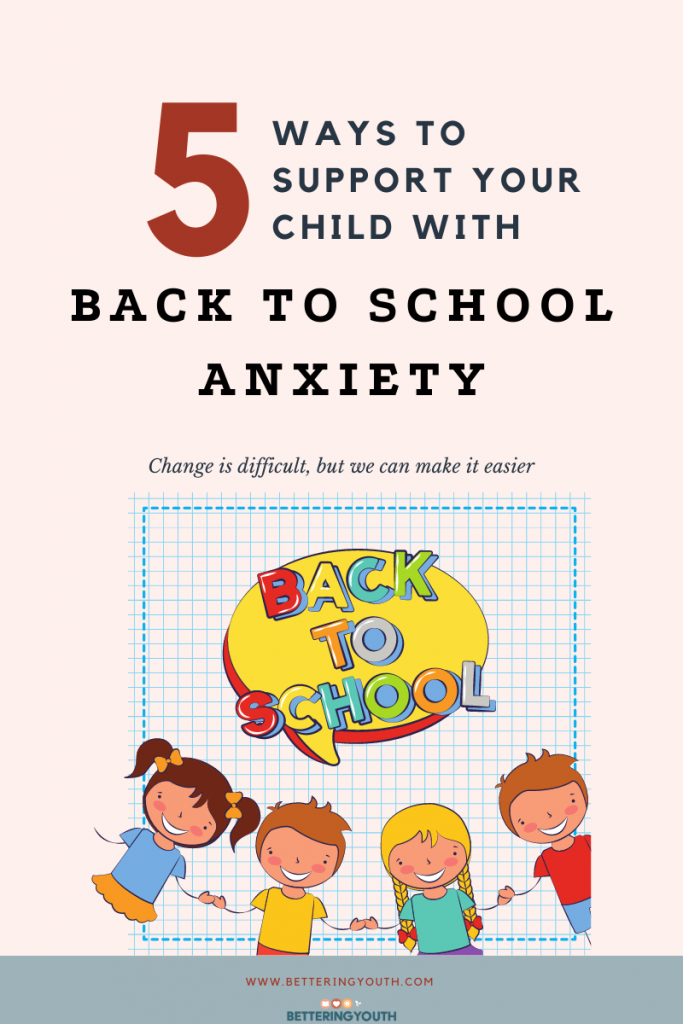I can still vividly remember sitting on the cold tile floors in our upstairs bathroom feeling weak and worrying that if I got up, I just might faint. I was not a fan of back to school season.
It was the first day of school and like every other year, I was locked in the washroom with more butterflies in my stomach than my tween body could handle.
At the time, I didn’t know that I was feeling a serious bout of nerves. I didn’t have the words to express that I felt worried about going to school and learning the new routines. I never knew that it was normal and okay to feel this way. All I knew, was that I felt awful: sweaty, shaky, sick. And I did NOT want to leave the safety of the washroom.

Children often don’t have the language to discuss their internal reality so it comes out as frustration, anger, inexplicable tears and mysterious belly aches. Which, when you’re trying to coax your 10 year old out of the toilet so they’re not late for school, can be incredibly frustrating for you as the parent. Teaching them how to prepare for change can eliminate much of that frustration.
Top 5 things to squash back to school anxiety
Here are the top 5 things I wish my parents would have done to support me in my Back to School anxiety. I hope that by sharing my hopes, you’ll be able to better prepare you child for change.
Acknowledge that change can be difficult
Before I was 13 years old, I attended 10 different schools.
Perhaps they underestimated the impact so much change had had on me. Or maybe they believed I was doing well because I got on with it and made friends fairly easily. Whatever the reason, let’s not sugar coat it: Change is difficult for any one, at any age.
This week sit with your child and honestly share that these last few months have brought about a lot of change that has been uncomfortable. They need to hear from you, their parent, that it isn’t easy. This helps them feel that it’s okay to have found things difficult. The simple act of acknowledging when something is challenging can eliminate the unnecessary pressure to do or be okay – even when they’re not.
Open a neutral conversation
Be the one to start the conversation. It gives your child the language to use, and the opportunity to explore their own emotions without pressure. Ask them: what part of being at home they have enjoyed; what part of being home they’ll miss; what they look forward to in being back at school, and what they might have concerns or questions about. By asking all of the questions you’re creating a neutral space, allowing them to share as much or as little as they feel ready to. This gives you insight in how you can support them.
Explore their concerns
It is important that we prepare our children for the changes they will experience this academic year. The more information we can provide them with, the more in control they will feel. Depending on your child’s age, you can research the information together (and talk about whether what they found comes from a quality source: bonus marks!) or you can keep up to date for your self and share the information in an age appropriate manner. The key here is to avoid the fear mongering and worries that come from the unknown.
If they still feel nervous
We don’t want children to spend their nights ruminating on the changes we’ve shared with them. Hearing that you may have to wear a mask all day, or that you won’t be able to play with your cousins who are in a different year group can be a trigger for some children. The fact is, we aren’t always going to like the reality and feel like we have little control which can be intimidating. However, let’s focus on what we do have control over: How we feel, and how we react. Make a plan with your child about how they will react to something they don’t like. It’s a powerful technique that puts them back in a position to make a decision.
Create an anxiety alleviation plan
Even with the best plans put in place, the more anxiety-prone children can still slip into a panic attack or some unhelpful behaviours. This is normal. Helping them to alleviate the anxiety requires having some helpful techniques in place before it starts.
- If your child has difficulty expressing verbally
If your child finds it difficult to express themselves with words when they get into these moods, creating a secret code word will help immensely! When someone experiences anxiety, sometimes their thought pattern gets stuck in a loop that won’t allow them to reach out for help. But if the word is simple, like Pineapples, then it allows them to express to you the state they are in without you having to wonder why they seem moody or off.
- Know how to support them
We’re all different and therefore will all want support in a different way. Finding ways to establish what your child needs when they feel anxious or worried will help you to support them, enable them to reflect and advocate for their needs, and create immense trust. Some children want someone to ask neutral questions until they can break out of the negative thought pattern. Some children will want to be cuddled and held tightly. Other children might want to be left alone for a bit. Others might want you to help them breathe and calm down. The key here is discussing this, and trying them out with patience and care. Like any new process, it will take time.
- Practicing calm down techniques
A key way to prepare your child for the unknown is to arm they with powerful re-centering techniques. One of my favourites to stop a rushing mind is the Superhero technique, aka the 5 senses technique. It’s important to practice all mindfulness techniques when children are not upset. While this technique is great for interrupting thought patterns, it can be overwhelming to those with sensory sensitivities. By practicing in advance, you ensure that your child will be able to decide if 1 or all 5 senses helps them to get grounded and calm.

Keep the conversation going
Let’s face it, life is busy and our day goes by in a blink. A key element that will help support your child to grow into a resilience and emotionally literate being is practice. Employ a family meeting every Sunday to: reflect on the previous week; talk about what’s coming up and; what plans need to be made. Or discuss the days “failures” every night at dinner to encourage a resilient family culture.
In Teachers College we were told about the importance of BATS, so please:
Borrow, Adapt, Take and Share any and all parts that resonate with you and your family. Leave a comment below of what you’re doing to help support your child with back to school.

Pingback: 7 Educators Tips For Classroom Wellbeing Post Covid-19
Pingback: Bring Mental Health to Life with Disney's Inside Out - Bettering Youth
Pingback: Back to School with Confidence Guide: How to Ease Anxiety - Bettering Youth
Pingback: 18 powerful ways to help them effectively deal with their emotions - Bettering Youth